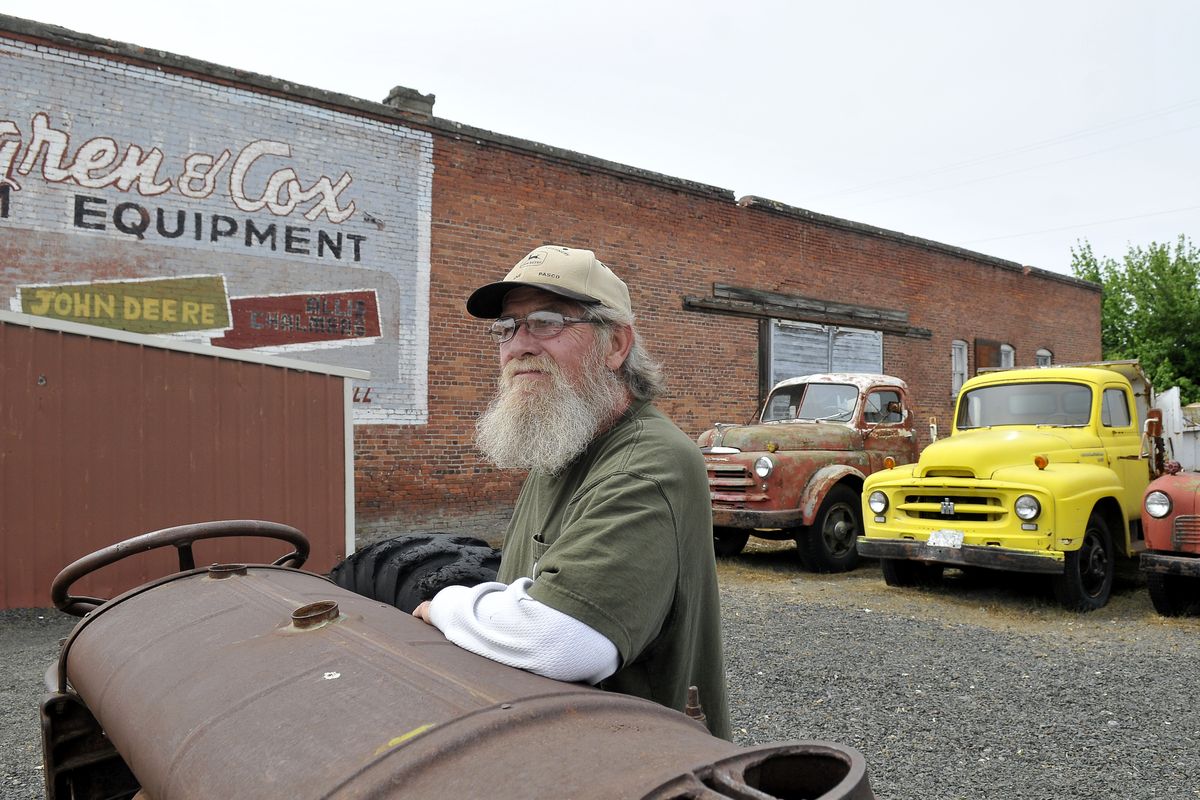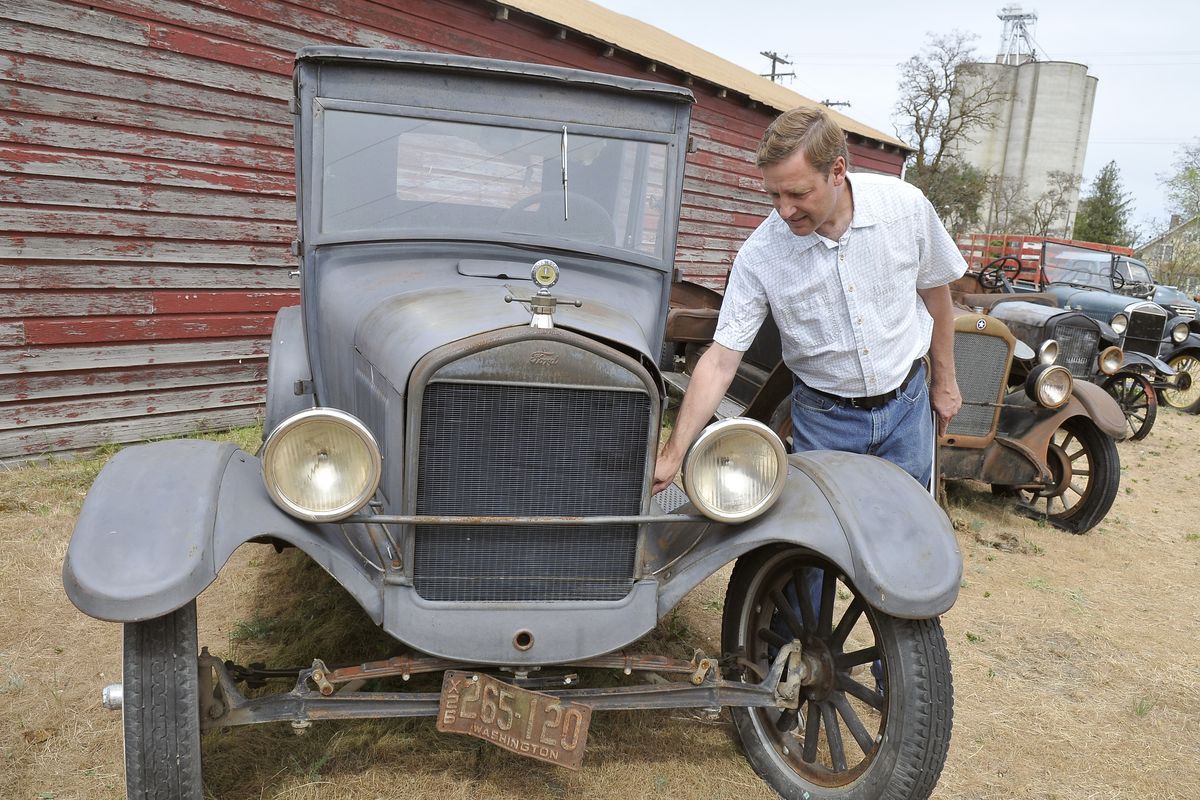Collection of classic vehicles lines, defines downtown Sprague
Dave Jones, of Sprague, Wash., has filled his shop, a storage building and an empty lot with old commercial trucks of all shapes and sizes, mostly made before 1960. His lot has become a tourist attraction, and he’s working with a photographer to publish a book about his collection. (Jesse Tinsley)Buy a print of this photo
SPRAGUE, Wash. – If seeing the classic lines of old Detroit steel stirs something inside you, then a trip to tiny Sprague might be worth the gasoline.
Dozens of aging cars and trucks going back to the Model T are parked on lots in this Lincoln County town along Interstate 90, less than an hour southwest of Spokane.
In fact, the locals claim Sprague has earned international attention for its historic auto collections and an emerging trade in old auto parts.
“I love history, and I love what the cars tell about the times,” said Dave Thompson, one of a group of collectors in Sprague. “Each era tells a different story of how people were.”
Thompson has 50 classics – about a third of his collection – parked near his home on the south end of town. Another 100 vehicles are parked in a field near Chewelah, Wash.
In the opposite direction, collector Dave Jones has more than 60 old farm trucks parked in lots and buildings on the north end of town.
And in the middle, antique shop owner Dorothy Giddings offers old car relics for sale in her Dot’s Farm Antiques shop.
“What makes me money now is this old-car stuff,” said Giddings, 82. “I’m having the most fun I’ve had in my life.”
Giddings and Thompson have teamed up to scour Eastern Washington for purchases. Together, they are offering items on eBay under Thompson’s online Applewood Mercantile.
Between 20 and 30 percent of the sales go to foreign countries where the lure of vintage American automobiles is drawing a whole new set of collectors.
“South America is big for the Model T,” Giddings said. She said she’s also shipped mirrors for a 1950 Corvette to Australia.
Some international fans are finding their way to Sprague to check out the collections.
Thompson said one couple from Germany dropped in to visit his collection on a cross-country tour from Seattle to New York. Other travelers discover the cars when they pull off I-90 for gas or a pit stop.
The mix of rust, chrome and oxidizing paint makes for great photographic subjects.
“I enjoy people just coming by,” Thompson said. “They’ll sit out here for hours.”
Packards are a favorite
Thompson, who works for the Post Office, said his love of cars began with the Matchbox toys he played with as a boy. He told his mother he’d live in a wrecking yard if he could.
So when Thompson, 53, got his driver’s license at age 16, one of the first things he did was buy a 1950 Chrysler Windsor Club Coupe from an owner in Mica for $400. “I had to borrow money from everybody” to make the purchase, he said.
That car is still part of his collection, decades later. “It’s about time for restoration,” he noted.
Thompson got his first Packard, a 1938 Super Eight, in lieu of salary for a summer spent working at a carnival in north Spokane. Sadly, his father had the car hauled away when he went off to college in Canada, Thompson said; his folks weren’t fans of old things.
Packard is his favorite make; he owns 45 of them, including a 1940 Packard Woody station wagon said to have been owned by famed conservationist and photographer Ansel Adams. It’s in rough condition with broken glass, rust and rotting wood, but enough remains that it could be restored, Thompson said.
A look inside shows an interlocking pattern of curving wood pieces on the headliner. “The detail is phenomenal,” he said.
But this collector’s favorite acquisition – one maybe worth $100,000 when restored – is a 1938 Packard convertible Thompson purchased in Chicago for $4,500 three years ago. Only 500 were built.
“I looked all my life for this car,” he said.
Thompson said he values old cars for many reasons, not least of which is their ability to reflect their eras. Model Ts, for example, were practical, inexpensive and maneuverable on rough terrain, which described many of the roads of that day. But by the 1950s, with the construction of a national highway system, people wanted speed, he said. The vehicles that remain from those eras evoke strong connections in people’s memories, he said.
‘Like a little gold mine’
Giddings, a retired supervisor at the Hanford complex, moved to Sprague from Benton City with her husband, Gary, to be close to the lake and fishing.
She’s been dabbling in antiques for 50 years and has honed her knack for the deal. She’s “mined” old farm dumps for tools, buckets and the like. Now, she’s turning to autos.
“It’s like a little gold mine,” she said.
Her plan for the store is to install a replica filling station built around an old gas pump she owns. Thompson is talking about opening a shop next door with a 1936 soda fountain he owns.
Giddings said historic autos could be the key to bringing more people to Sprague and helping an economy depressed for decades.
Trucks in book, on website
Jones talks about his trucks – one of the first things a visitor to Sprague sees – as if they have personalities. “This guy came from Yakima. That guy came from Lamont,” he said. There’s a logging truck from Mount Spokane and a school bus from Ford.
“I’ve got a ’37 inside that still runs,” Jones said of his half-ton Chevy.
Most of his purchases came from farms where the vehicles sat outside for years. “I had one that was buried two and a half feet in the dirt,” he said.
Jones is a retired farmer who drove these kinds of trucks in his working years. Since 2011, he has been collaborating with a photographer from Massachusetts on a book and website. Both are titled “Dave’s Old Truck Rescue.”
When scrap metal prices rose several years ago, people could sell old car hulks for $600 to $800, which resulted in a lot of them being lost, Jones said. He figures three-quarters of his trucks would have met that same fate if he hadn’t acquired them.
Jones bought his first trucks two decades ago, and the hobby has “kind of snowballed” since then, he said.
He isn’t inclined to sell any of them; having the collection is more important, he said.
Thompson said he feels the same way but will part with one of his collector autos if it means he can buy a better one.
Giddings is different in that regard; she’s a name-your-price type of person.
But for all three, the thrill of buying more rusted treasure won’t go away soon. “I know where another 200 of them are,” Jones said.

